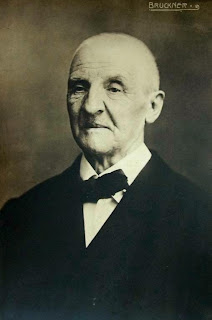Composer: Anton Bruckner
- Symphony No. 7 in E Major (1885, ed. Haas)
Stuttgart Radio Symphony Orchestra
Kurt Sanderling, conductor
Date: 1999/2018
Label: SWR
----------------------------------------------------------------------------
Recorded live in 1999, this South-West German Radio performance of Bruckner's Seventh Symphony is testimony to the work of one of the great conductors of recent times. Kurt Sanderling worked with orchestras throughout Europe and he left an important legacy of recordings, many of which are no longer in the catalogues. Therefore the arrival of this Bruckner CD from SWR's Classic label is especially welcome.
Both the recording and the performance are first class; and so too is the behaviour of the audience, which is always a consideration with live broadcasts. The orchestral playing is of the highest calibre, with abundant atmosphere and great power too.
There is only one issue concerning editions with this piece, of course. That is the question of whether or not there should be a cymbal clash at the peak of the climax in the great slow movement. Sanderling opts for the Haas edition, which means the contentious cymbal clash in the Adagio is not included (whereas it is there in the Nowak edition). For listeners who might feel short-changed, there is no cause for worry, either musically and sonically, since the movement's great climax makes an overwhelming effect, leading as it does to the great postlude in tribute to Wagner, with noble brass to the fore.
From the very first bar, Sanderlings choice of tempi are perfect for presenting the composer's eloquent symphonic lines. There is that unique subtlety of tension and relaxation which delineates any successful Bruckner interpretation. As an obvious example, the first movement begins beautifully, the great opening theme presented with wonderful sonority, amid phrasing which encourages the melodic line to breath and grow. In the succeeding phase, the more angular rhythmic contours of the secondary material create an ideal balance as the extended symphonic plan unfolds built across its twenty-minute span.
The slow movement is deeply serious: noble, thoughtful and ultimately majestic. Sanderling articulates it with great sensitivity as a genuine Adagio, releasing the inspired themes stage by stage and with a long-term vision. The results are undeniably compelling, while towards the conclusion the 'funeral music for the master', as Bruckner called his tribute to Wagner, is at once eloquent and deeply felt, imbued with the sombre tones of the Wagner tubas.
The Scherzo offers the contrast of an energetic rhythmic propulsion, the principal trumpet brilliantly leading the way. The finale recalls the moods and manner of the first movement material, albeit employing a somewhat faster pulse, which broadens at the close when the principal theme returns, to confirm the bond of symphonic unity upon the whole magnificent conception. This is a great performance, eloquently projecting some of Bruckner's most gloriously lyrical music, while emphasising the music's powerful dramatic range with an equally compelling conviction.
-- Terry Barfoot, MusicWeb International
----------------------------------------------------------------------------
Anton Bruckner (4 September 1824 – 11 October 1896) was an Austrian composer. His symphonies are considered emblematic of the final stage of Austro-German Romanticism because of their rich harmonic language, strongly polyphonic character, and considerable length. Bruckner composed eleven symphonies, scored for a fairly standard orchestra; his orchestration was modeled after the sound of his primary instrument, the pipe organ. Despite being criticized for their large size and use of repetition, Bruckner's symphonies was greatly admired by subsequent composers, including his friend Gustav Mahler.
***
Kurt Sanderling (19 September 1912 – 17 September 2011) was a German Jewish conductor. He fled the Nazi in 1936, left for Soviet Union. From 1942 to 1960, he was joint principal conductor with Yevgeny Mravinsky of the Leningrad Philharmonic. He was also a close friend of Dmitri Shostakovich. He returned to East Germany where he led the Berlin Symphony Orchestra and Dresden Staatskapelle. He made his British debut in 1970 and later became particularly associated with the Philharmonia Orchestra. Sanderling announced his retirement from conducting in 2002. His three sons are also conductors.
----------------------------------------------------------------------------
FLAC, tracks
Links in comment
Enjoy!



Choose one link, copy and paste it to your browser's address bar, wait a few seconds (you may need to click 'Continue' first), then click 'Skip Ad' (or 'Get link').
ReplyDeleteIf you are asked to download or install anything, IGNORE, only download from file hosting site (mega.nz).
If MEGA shows 'Bandwidth Limit Exceeded' message, try to create a free account.
http://fumacrom.com/3LVnQ
or
https://uii.io/0ICM7NwG
or
https://exe.io/qtr5